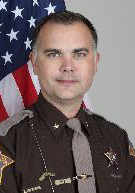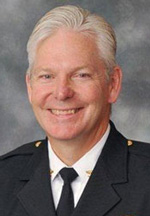Reporter Publisher
Editor’s note: Today’s article is the last in a three-part series concerning Indiana House Bill 1253 and armed school employees.
House Bill 1253 creates a specialized firearms safety, education and training curriculum for Indiana teachers, school staff and school employees. The bill, approved by the House and waiting Senate approval, authorizes funds from the Indiana Safe Schools Fund to be used for curriculum related expenses. The bill also requires the list of school employees taking the firearms course to be kept confidential.
Local law enforcement leaders agree: If school employees are going to be armed, they need training; however, they do have concerns.

Quakenbush
“I think this bill is a step in the right direction if we are going to have school employees with guns on school property. However, just like our officers in the field, there needs to be continual training,” said Hamilton County Sheriff Dennis Quakenbush.
Carmel Police Chief Jim Barlow agreed with the Sheriff. Barlow’s department is responsible for the safety of nearly 16,000 students and 2,000 teachers. CPD has seven officers assigned to Carmel Clay Schools.
“If a school district permits its employees to carry a gun in classrooms and school property, they need to be trained,” said Barlow. “But, it’s not just that simple. There are a lot of things that need to go into it, like ongoing training. Police officers continually train with their firearms and use of force situations. Should teachers and school employees be held to the same standards? Is it going to take away from what teachers do best … teach? Before our officers are hired they are evaluated physically and psychologically. Before we put a gun in their hands we need to know if they can respond appropriately to a use of force situation.”

Jowitt
Noblesville Police Chief Kevin Jowitt said, “I can’t think of a more stressful shooting situation than having to shoot an armed assailant inside a school. Is that something a teacher can ultimately respond to? If not, that gun could potentially become an additional threat.”
Jowitt believes even though the list of school employees completing the training is confidential, an armed school employee could potentially become a target. “Kids are especially aware of school safety measures.”
Barlow feels arming teachers and school employees creates as many questions as it does answers. “It could be difficult for police officers responding to an active shooter to determine the good guys from the bad guys.”
Barlow, along with Quakenbush and Jowitt, expressed concern about who would do the training.
HB 1253 requires the person doing the training be an instructor who is, or instructors who are, qualified to provide instruction in the topics described in the bill.

Barlow
“A real concern of mine is, who’s the instructor?” said Barlow. “Our qualification standards are established by the state and training is conducted by state certified instructors. Who will be training teachers and what makes them qualified to instruct the course?”
Sheriff Quakenbush said Indiana already permits school employees to carry guns inside schools. “It is up to their local boards. I am confident that if our schools would implement a firearms policy, we would have cooperation with the school officials on how they implemented it and who would be permitted to have a firearm inside a school.”
“Overall you have to look at HB 1253 on a state level,” said Jowitt. “Not every county is as fortunate as Hamilton County. We have a large police presence within a few minutes of our schools. It isn’t that way in the state’s rural counties.”
When asked if there was a more effective use of the state’s money than providing firearms training for teachers, Barlow, Jowitt and Quakenbush each agreed: “More police officers in the schools.”
“The single best safety measure is trained armed school resource officers,” concluded Jowitt.
HB 1253 received its first reading in the Senate on March 4 and is now in the hands of the Education and Career Development committee.
